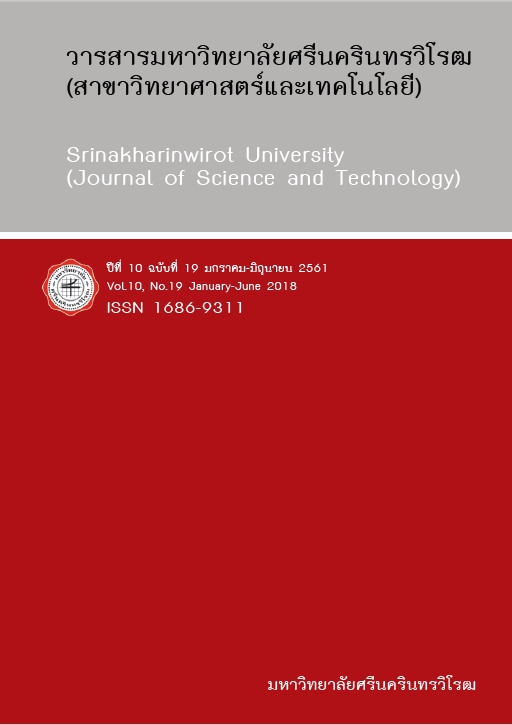การกำจัดก๊าซไนโตรเจนมอนอกไซด์ด้วยตัวเร่งปฏิกิริยา Ce-Cu/Core-shell Al-MCM-41: ผลของการเคลือบไซเลน (NOx REMOVAL BY CE-CU/CORE-SHELL AL-MCM-41 CATALYST: EFFECT OF SILANE COATING)
Keywords:
Silane, Mesoporous Silica, Alumino-Silicate, Reduction, Nitrogen MonoxideAbstract
Air pollution and global warming have affected to human living and created many fatal diseases.
This work, thus, aims to decrease nitrogen monoxide, which is one of greenhouse gases and can cause acid rain, by converting it to N2 and H2O through a reduction pathway. In order to prolong the activity of the catalyst used, silane (i.e., chlorodimethylsilane, CDMS) was used to modify the surface of the catalyst—Ce and Cu loaded on a core-shell mesoporous silica-aluminosilicate composite (1.5%-Ce-SEI-Cu/Al-MCM-41).
The physico-chemical properties of the synthesized catalysts were characterized by using an X-ray diffraction (XRD), scanning electron microscope (SEM), transmitting electron microscope (TEM), and H2 temperature-programmed reduction (H2-TPR). It was found that when higher concentration of silane was used to modify the catalysts, the lower NO conversion was obtained from the NO reduction conducted under dry condition using catalysts modified with different silane concentration. The pristine 1.5%-Ce-SEI-Cu/Al-MCM-41 catalyst gave the average NO conversion of 53%, while the 1.5%-Ce-SEI-Cu/Al-MCM-41 coated with 0.1, 0.25, 0.5, and 0.75 mmol of silane gave average NO conversions of 52, 48, 45, and 44%, respectively. However, under wet condition using the 1.5%-Ce-SEI-Cu/Al-MCM-41 modified with 0.5 mmol silane yielded the highest NO conversion of 53%, which is much higher than that of pristine 1.5%-Ce-SEI-Cu/Al-MCM-41 catalyst. It can be concluded that the hydrophobicity of silane helps the catalyst to prolong its activity under wet condition by retarding the deactivation of catalyst caused by water.
Downloads
References
[2] J.V. Caneghem, J.D. Greef, C. Block, C. Vandecasteele. (2016). “NOx reduction in waste incinerators by selective catalytic reduction (SCR) instead of selective non catalytic reduction (SNCR) compared from a life cycle perspective: a case study”. Journal of Cleaner Production. 112: 4452-4460.
[3] Z.B. Xiong, Q. Hu, D.Y. Liu, C. Wu, F. Zhou, Y.Z. Wang, J. Jin, C.M. Lu. (2016). “Influence of partial substitution of iron oxide by titanium oxide on the structure and activity of iron-cerium mixed oxide catalyst for selective catalytic reduction of NOx with NH3”. Fuel. 165: 432-439.
[4] M. Chen, J.W. Chu. (2011). “NOx photocatalytic degradation on active concrete road surface-from experiment to real-scale application”. Journal of Cleaner Production. 19: 1266–1272.
[5] J.C. Martín, S.B. Rasmussen, S. Suárez, M. Yates, F.J. Gil-Llambías, M. Villarroel, P. Ávila. (2009). “Effect of sulphuric acid pretreatment concentration on the behaviour of CoOx/-Al2O3-SO4 monolithic catalysts in the lean CH4-SCR process”. Applied Catalysis B: Environmental. 91: 423-427.
[6] M. Foix, C. Guyon, M. Tatoulian, P.D. Costa. (2010). “Study of the use of fluidized bed plasma reactors for the treatment of alumina supported palladium catalyst: Application for SCR NOx by CH4 in stationary sources”. Catalysis Communications. 12: 20-24.
[7] L. Gutierrez, A. Boix, H. Decolatti, H. Solt, F. Lónyi, E. Miró. (2012). “Further insights on the physico-chemical aspects of PdIn-Hmordenite catalysts for the NOx-SCR with CH4”. Microporous and Mesoporous Materials. 163: 307-320.
[8] Z. Schay, L. Guczi, A. Beck, I. Nagy, V. Samuel, S.P. Mirajkar, A.V. Ramaswamy, G.P. Borbély. (2002). “DeNOx reactions on Cu-Zeolites decomposition of NO, N2O and SCR of NO by C3H8 and CH4 on Cu-ZSM-5 and Cu-AlTS-1 catalysts”. Catalysis Today. 75: 393-399.
[9] Y. Li, J. Su, J. Ma, F. Yu, J. Chen, R. Li. (2015). “Novel straight synthesis of super-microporous Cu/Al2O3 catalyst with high CH4-SCR-NO activity”. Catalysis Communications. 65: 6–9.
[10] B. Ivanov, I. Spassova, M. Milanova, G. Tyuliev, M. Khristova. (2015). “Effect of the addition of rare earths on the activity of alumina supported copper cobaltite in CO oxidation, CH4 oxidation and NO decomposition”. Journal of Rare Earths. 33: 382-390.
[11] I.O. Costilla, M.D. Sanchez, M.A. Volpe, C.E. Gigola. (2011). “Ce effect on the selective catalytic reduction of NO with CH4 on Pd-mordenite in the presence of O2 and H2O”. Catalysis Today. 172: 84-89.
[12] R.Q. Long, R.T. Yang. (1999). “Selective Catalytic Reduction of Nitric Oxide with Ethylene on Copper Ion-Exchanged Al-MCM-41 Catalyst”. Industrial and Engineering Chemistry Research. 38: 873-878.
[13] B. Chamnankid, T. Witoon, P. Kongkachuichay, M. Chareonpanich. (2011). “One-pot synthesis of core–shell silica–aluminosilicate composites: Effect of pH and chitosan addition”. Colloids and Surfaces A: Physicochem. Eng. Aspects. 380: 319–326.
[14] B. Chamnankid, S. Rattanaporn, P. Kongkachuichay. (2012). “Effect of Core-Shell Structure and Chitosan Addition on Catalytic Activities of Copper- Containing Silica-Aluminosilicate Composites in deNOx Reaction by H2”. Journal for Nanoscience and Nanotechnology. 12: 9325–9332.
[15] T. Intana, K. Föttinger, G. Rupprechter, P. Kongkachuichay. (2015). “Physicochemical properties of Cu loaded onto core-shell Al-MCM-41: Effect of loading methods”. Colloids and Surfaces A: Physicochem. Eng. Aspects. 467: 157-165.
[16] A. Nakajima, T. Miyamoto, M. Sakai, T. Isobe, S. Matsushita. (2014). “Comparative study of the impact and sliding behavior of waterdroplets on two different hydrophobic silane coatings”. Applied Surface Science. 292: 990-996.
Downloads
Published
How to Cite
Issue
Section
License
Srinakharinwirot University Journal of Sciences and Technology is licensed Under a Creative Commons Attribution-NonCommercial-NoDerivs 4.0 International (CC-BY-NC-ND 4.0) License, Unless Otherwise Stated. Please Read Journal Policies Page for More Information on Open Access, Copyright and Permissions.



